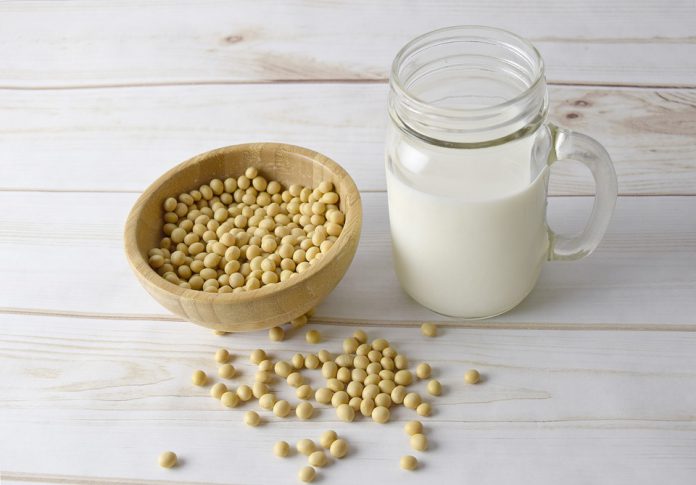Is soy helpful to ease the symptoms of perimenopause? As more women enter this transitional phase of life and confront the challenges of perimenopause, soybeans are garnering interest from patients and providers alike.
Why soybeans, you might be wondering? Soybeans contain isoflavones, a naturally-occurring source of phytoestrogen, or plant-based estrogen (phyto = plant).
Ongoing research is investigating the potential for using soybeans to help ease menopause symptoms naturally. In this article, find out what the research has to say about soy for menopause symptoms!
What are the Benefits of Soybeans for Menopausal Women?
“the presence of phytoestrogens might not be the only reason soybeans have potential benefits to offer for easing perimenopause symptoms.”

Soy isn’t the only plant food that contains phytoestrogens by far, but soybeans do contain plentiful amounts of this plant-based natural chemical.
Because soybeans represent such a good potential source of phytoestrogen, researchers are wondering if they could perhaps supplement or even be a substitute for traditional hormone replacement therapy (HRT) for women experiencing difficult perimenopause symptoms.
The two main isoflavones in soy that are being studied are called genistein and daidzein. But the presence of these phytoestrogens might not be the only reason soybeans have potential benefits to offer for easing perimenopause symptoms.
Soybeans are also rich in B vitamins, magnesium, potassium and fiber, each of which has an important role to play in easing other perimenopause symptoms ranging from insomnia to constipation.
What Studies Say About Soy’s Effectiveness in Easing Menopausal Symptoms?
“Several research studies have demonstrated that increasing daily soy intake may reduce the risk of breast cancer, thinning bones (osteoporosis) and high cholesterol”

So what do the research studies say about soybean for menopause symptoms? The first thing to know is that dietary soy is available in many different preparations today, from whole soybeans to tofu and tempeh to soy powder.
Different preparations can have different amounts of each major isoflavone. As well, women from different cultures can metabolize these isoflavones differently, which then contributes to how well (or if) taking soy eases their symptoms.
It is also important to know that the concentration of phytoestrogens in soy is at most 1/1000th as potent as the equivalent of natural estradiol, a popular choice for hormone replacement therapy.
A lack of standardization in research studies to date has led to conflicting results about if or how well soy may help alleviate estrogen-related perimenopause symptoms.
In one of the more recent reviews of a number of research studies focused on the use of soy for menopause symptoms, this natural therapy appeared to help reduce hot flashes and vaginal dryness but not a reduction in night sweats.
Several research studies have demonstrated that increasing daily soy intake may reduce the risk of breast cancer, thinning bones (osteoporosis) and high cholesterol, but increased soy may in turn increase the risk for endometrial cancer.
Research also shows that substituting genistein-rich soy products for traditional hormone replacement therapy typically delivers 40 percent less effective results for easing hot flashes.
How to Incorporate Soy in Your Daily Diet?
“For some women, adding soy can cause mild digestive disturbances because soy is naturally high in starch.”

Here, the challenge is one of choosing your soy products wisely and of learning how (and how well) your body absorbs the isoflavones in the soy you eat.
It is very important to do your research to learn about the concentration of isoflavones in different soy foods.
This helpful chart can give you a place to start in choosing which soy-based foods to add to your diet.
If you are new to eating soy, you can also learn more about the many types of soybean foods and how they are served in this helpful article.
For some women, adding soy can cause mild digestive disturbances (constipation or diarrhea, bloating or gas) because soy is naturally high in starch. For this reason, it can be smart to ease into your soy intake, adding just a little each day until your body gets acclimated to your change in diet.
Should you use soybean for menopause symptoms? This is a very personal question that is best answered after factoring in the frequency and severity of your perimenopause symptoms and taking a comprehensive look at your treatment options.
Some women cannot take traditional hormone replacement therapy or simply do not want to due to the known health risks. If this describes you, it may be worthwhile to experiment with adding some soy foods to your diet to see if your perimenopause symptoms are eased.
Sources & References:
https://www.healthline.com/health/phytoestrogens
https://www.hsph.harvard.edu/nutritionsource/soy/
https://www.medicinenet.com/can_soy_help_menopause_symptoms/ask.htm
https://jamanetwork.com/journals/jama/fullarticle/2529629
https://healthbeat.spectrumhealth.org/aging-gracefully-soy-menopause/
https://lpi.oregonstate.edu/mic/dietary-factors/phytochemicals/soy-isoflavones
https://thefemedic.com/menopause/soy-safe-alternative-hrt/
http://www.berkeleywellness.com/healthy-eating/food/article/types-soyfoods





















